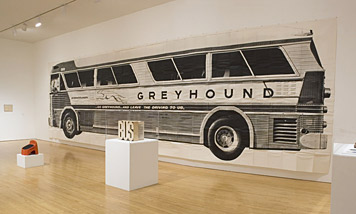Schwarz
View current page
...more recent posts
aint it....!
via zoller
justin snags another good shipping container cabin find
"art is either plagiarism or revolution."
-paul gauguin
now can someone get me a job at one of those stupid net surfing art clubs. i can spell fuked up on purpose too.
our friend linda found tables made from reclaimed bowling lanes at the BKLN flea market
porch board
via vz
this is quite a grand discovery for me. at age 13 i visited some cousins in evanston Ill. on the first opportunity i took the train into chicago and headed straight to the old town district. there in a prospering bi-level head shop, hung high on the wall i spotted a life sized poster of a greyhound bus. its stuck with me ever since. epic (!) looking generically warholian (screened americana) and 100% pop (think rosenquist and oldenburg BIG). since the age of the internet ive searched off and on but not until this moment have i found the "A"uthor. turns out, it was mason williams.
i try not to be seduced by the fetish aspects of nakashima furniture. really, they are just straight up trestle tables. free edges? just short cuts to a completed work station. butterfly keys? you need them for mending slabs of wood which might not make the grade otherwise. but this table in rosewood, well it did me in. me and someone with 210k.
In 1954 the artist Asger Jorn wrote to Max Bill, “Bauhaus is the name of an artistic inspiration.” Bill, a former Bauhaus student and the founding director of the newly opened Hochschule für Gestaltung in Ulm, West Germany, a self-anointed successor to the Bauhaus, replied, “Bauhaus is not the name of an artistic inspiration, but the meaning of a movement that represents a well-defined doctrine.” To which Jorn shot back, “If Bauhaus is not the name of an artistic inspiration, it is the name of a doctrine without inspiration — that is to say, dead.”1from the spring/summer '08 HDM online
This exchange between the orthodox Bill, who would run his school like a monastery, and Jorn, who as a provocation would create something called the International Movement for an Imaginist Bauhaus before going on to cofound the Situationist International a couple years later, was more than just an epistolary joust. Virtually since its founding in 1919, throughout its fourteen-year existence in Weimar, Dessau, and Berlin under three successive directors, and in the three quarters of a century since it closed its doors in advance of the Nazis, the Bauhaus has been the object of veneration, hostility, controversy, and myth. It has been variously portrayed as a seminal experiment in pedagogy, a hotbed of radicalism, the standard-bearer of the ethos of functionalism and industrial technology, an aesthetic style, and most broadly, an “idea” synonymous with the spirit of early 20th-century modernity itself. In a new collection of essays thoughtfully edited by Kathleen James-Chakraborty, it is a cultural manifestation closely linked to the political and economic vicissitudes of its times.
Authorship in design is a sticky question, and always has been. There are a few considerations: collaboration, control, voice, and limits. The questions that follow from these considerations are simple enough. If—like architects or filmmakers, but unlike bookwriters or oil painters—we collaborate on our projects with a huge array of people, including paying clients, regulatory and legal institutions, fellow design staff and subcontractors, printers and fabricators, merchants and mailing houses, are we even able to “author” a work? To aid us in this discussion on collaboration’s impact on authorship, some designers (in particular Michael Rock) have pointed out Andrew Sarris’s auteur model, developed for the analysis of filmmaking.
rago has two modern design auctions a year. last fall we saw a frail but spirited Philip Lloyd Powell in the auction room looking very elfin. sadly he has passed on since then. here are some shots of my brothers small PLP side table that came from a little east village thrift shop called "garage sale" which was located on 1st avenue and second street back in the 80's.
back from the rago auction showroom with (up-skirt) images of george nakashima splayed and tapered table legs.

